The Economics and Statistics Division maintains archives of previous publications for accountability purposes, but makes no updates to keep these documents current with the latest data revisions from Statistics Canada. As a result, information in older documents may not be accurate. Please exercise caution when referring to older documents. For the latest information and historical data, please contact the individual listed to the right.
<--- Return to Archive
For additional information relating to this article, please contact:
March 17, 2023HALIFAX BUSINESS CONDITIONS: MARCH 6 - 12, 2023 Statistics Canada has released real-time local business conditions from March 6 to March 12, 2023. Throughout this article, reference dates mean the start of the week. Note that these data are not adjusted for seasonality and changes may simply reflect regular seasonal patterns.
From August 10 of 2020 to the week starting March 6, 2023, the local business conditions index for Halifax has increased by 67.2%. In percentage terms, Regina and Québec City reported the strongest growth in business conditions over this period while Halifax had the smallest gain (followed by Ottawa and Hamilton).

In the week of March 6 to 12, Halifax business conditions declined 18.4 from the previous week. Business conditions declined in all cities with Abbotsford and White Rock reporting the largest drops.
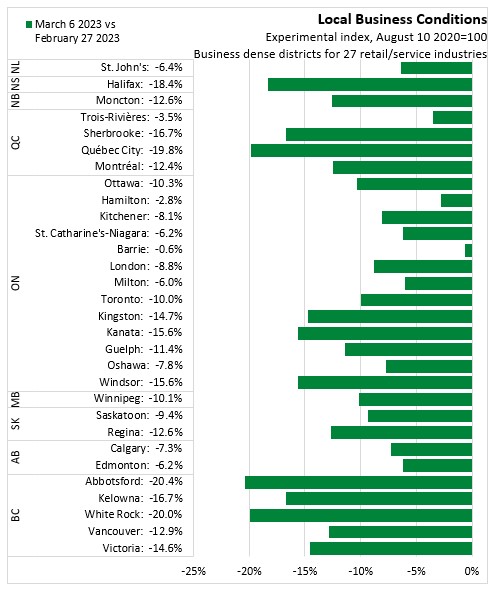
Compared with 4 weeks prior, business conditions increased 8.6% in Halifax. Business conditions were down in most major cities compared with 4 weeks prior. St. John's posted the largest gain while Abbotsford posted the largest decline.
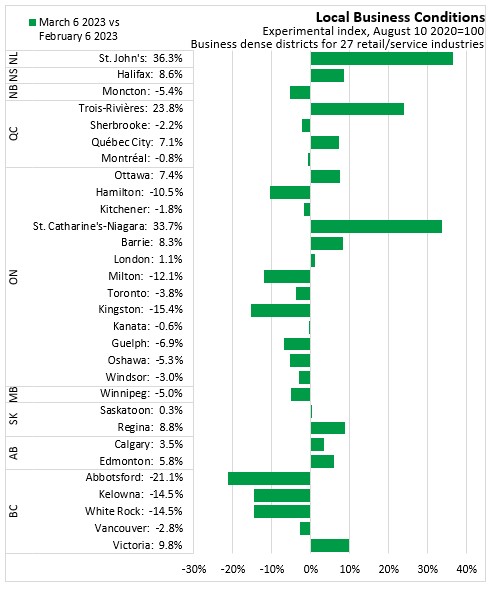
Compared with the same week a year ago, Halifax business conditions have improved by 31.0%. All cities reported improvements, with Windsor and Calgary reporting the largest increases. The smallest improvements were reported in Hamilton and Moncton.
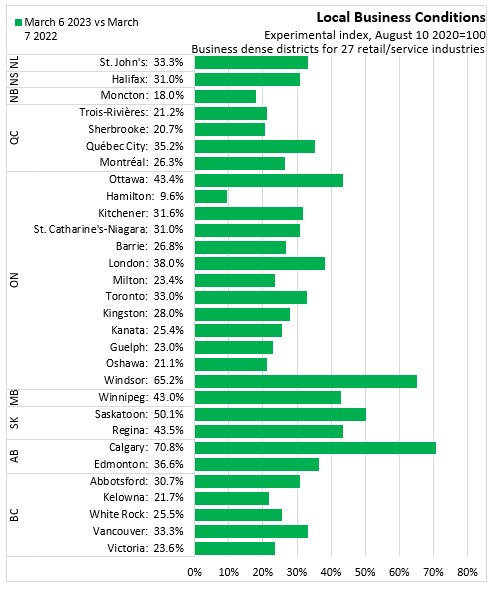
As the experimental business conditions index is both volatile and unadjusted for seasonality, a comparison of year-to-date averages may generate more stable (if less current) insights into changing business conditions.
Compared with the first nine weeks of 2022, Halifax business conditions were up 48.3% in the same period of 2023. Over this period, Calgary reported the largest gain while Hamilton reported the smallest. No urban centres reported a year-to-date decline in business conditions.
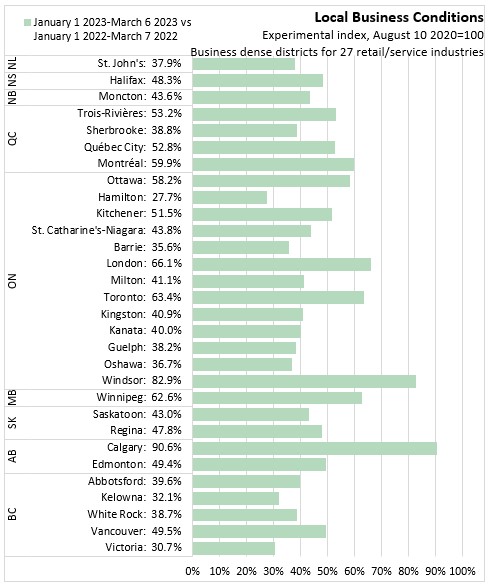
Halifax's business conditions generally follow trends observed in Canada's largest urban centres, with spikes during events like tropical storm Fiona and the World Junior Hockey Championship and notable declines in the first part of the year. Although the decline in winter 2023 appeared faster and larger than in previous years, the rebound reported in the last week was also sharper than observed in 2021 and 2022.

Halifax's business conditions have contracted below those of almost all other medium-sized cities. As in Halifax, many cities reported slipping business conditions during winter and a rebound at the end of February.
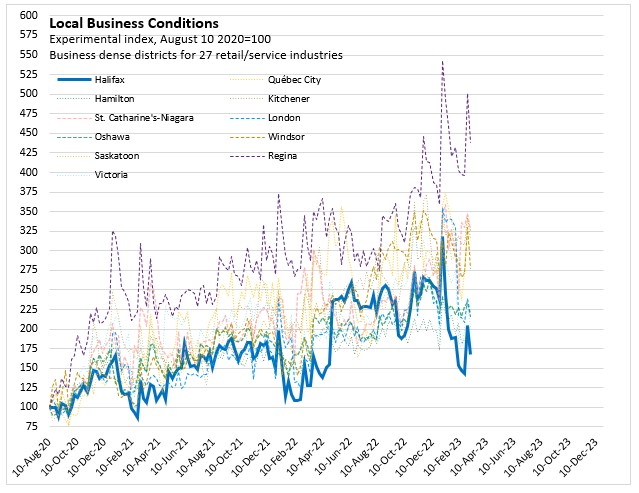
Growth in Halifax's business conditions continues to lag those in Canada's smaller urban centres.
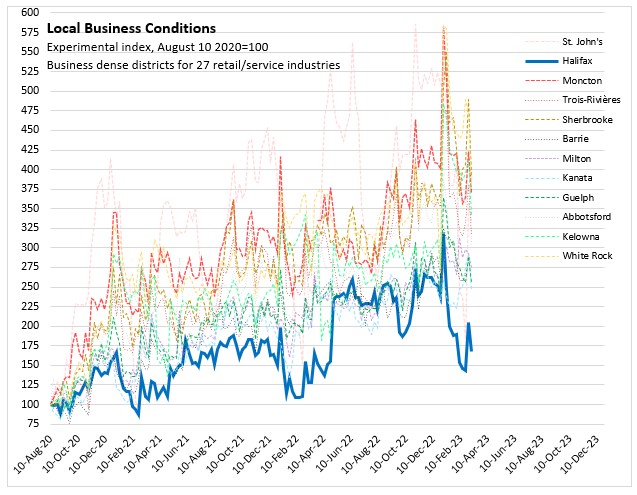
Notes
This experimental data product starts from information on the number of businesses listed in the business register in "business dense areas" of a large urban centre. Data from 2019 business locations provided baseline (ie: pre-pandemic) insight on business revenue and employment.
The data focus on 27 industries in particular: retail bakeries, furniture stores, electronics/appliance stores, building materials/garden supply stores, food/beverage stores, gas stations/convenience stores, clothing stores, cycling stores, book stores, general merchandise stores, florists, cinemas, dental offices, museums, zoos/gardens, amusement/theme parks, casinos, fitness/recreation centres, bowling alleys, drinking places, restaurants, and personal care services (such as hair care or esthetics).
Data on current operating conditions (open vs. closed) were collected from commercial application-program interfaces (API). Most of the information is drawn from Google's Places API, which is similar to what is available publicly on Google Maps, with supplementary information from APIs offered by Yelp Fusion and Zomato. Queries to the API are based on a sampling approach ('density-based cursory search') that focuses on the densest areas for business locations in the selected industries. Statistics Canada cautions that the sampling methods used do not follow standard statistical methods due to cost and technical limitations.
Data on current traffic volumes were drawn from TomTom's historical traffic information. As with operating conditions, the information was drawn from a sample of routes within identified business-dense areas. Statistics Canada cautions that traffic volume estimates and their relationship to business conditions may be sensitive to changing traffic patterns, construction/detours, and changes to business models such as curbside pickup or delivery.
The index of real-time local business conditions is estimated as the value of retail revenue, adjusted for both percentage of reported business closures as well as changes in traffic volumes from pre-pandemic levels.
The value of the index was set to 100 as of August 2020. As such, the index shows changes since then, but does not represent the variations in business conditions that existed in the initial period. A location with strong local business conditions in August 2020 would have less opportunity to grow than a location with weak conditions in the same month.
Source: Statistics Canada. Table 33-10-0398-01 Real-time Local Business Condition Index (RTLBCI)
Statistics Canada catalogue 71-607X. Real-Time Local Business Conditions Index: Concepts, data, methodology, https://publications.gc.ca/collections/collection_2021/statcan/71-607-x/71-607-x2021017-eng.pdf, July 15, 2021
<--- Return to Archive